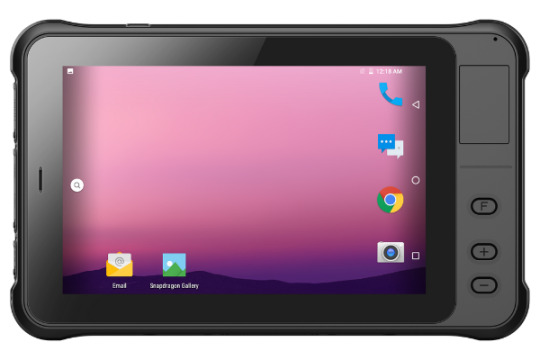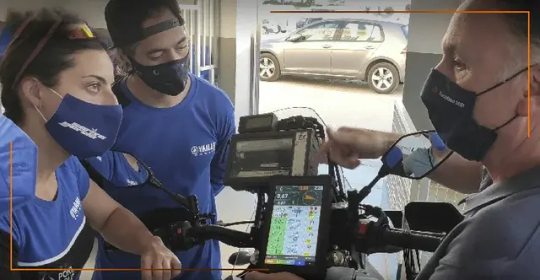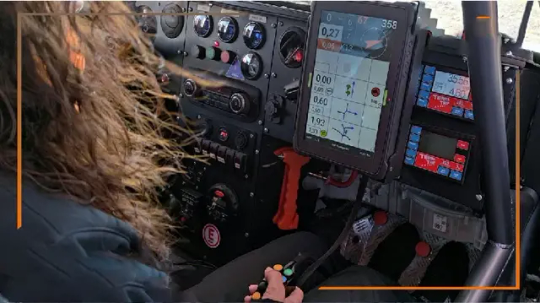#SemiRuggedNotebookPC
Explore tagged Tumblr posts
Text
5GRUGGED tablet, 5G Android and Windows Rugged tablet rankings | Ruggtablets
5Gruggedtablet,5GAndroid&WindowsRobustostablet排行榜我们国家准备2020年商用5G,而From a global perspective, competition is relatively fierce. The United States is also some commercial in 2018. Behind this is the competition of the industry. Domestic manufacturers need to accumulate and leap in global competitiveness. 5GRUGGED tablets will be used in more and more industries. 1) What is the tablet computers Rugged tablet, waterproof, dustproof, drop-proof, anti-pressure, and shockproof general environmental engineering related matters and laboratory testing. Common IP dustproof waterproof, 3C, national military standard, US military standard MIL STD-810G Wait, the communication method with WIFI, Bluetooth, GPS, and Beidou is used to use 4G before, and now 5G can be used. 2) 5GrugGED tablets 5Grugg ED tablets are very large in features that 5G, 5G's communication speed will be much faster than 4G, support more and more comprehensive frequency bands. It is very suitable for large -capacity videos to transmit long -distance transmission. arrive. Waiting for the comprehensive completion of 5G base stations now, the transmission speed of 5GRUGGED tablets will definitely be more stepped.

3)5Gruggedtablet排行 1. WindowsRugged tablet 5G Features: 12 Inch, high -performance 6Y30 and 7Y30 processor, keyboard removable, IP65 dustproof waterproof and anti -waterproof 5G frequency band: 5G NR: N1/N2/N3/N7/N8/N12/N28/N28/N41/N66///N66/ n71/n77/n78/n79 LTE-FDD: B1/B2/B3/B4/B7/B8/B9/B12/B13/B17/B18/B19/B20/B21 (TBD)/B25/B26/B28/B29/B30/B32/B66/B71 LTE-TDD: B34/B38/B39/B40/B42/B43/B48 La: B46 WCDMA: B1/B2/B3/B4/B6/B8/B8/B19 Features: 8 Inch, Xiaolong 690 processor, Octa-Core frequency 2.0GHz, 4+64GConfiguration 5G frequency band: 5G NR: N1/41/77/78/79 tdd-lte: B34/38/39/40/41 fdd-lte: b1/3/5/8 TD-SCDMA: B34/39 WCDMA: B1/5/8 EVDO: BC0 CDMA: BC0 GSM: B5/3/8 The above is the introduction of 5GrugGED tablet (Android and Windows). Read the full article
0 notes
Text
5GRUGGED tablet, 5G Android and Windows Rugged tablet rankings | Ruggtablets
5Gruggedtablet,5GAndroid&WindowsRobustostablet排行榜我们国家准备2020年商用5G,而From a global perspective, competition is relatively fierce. The United States is also some commercial in 2018. Behind this is the competition of the industry. Domestic manufacturers need to accumulate and leap in global competitiveness. 5GRUGGED tablets will be used in more and more industries. 1) What is the tablet computers Rugged tablet, waterproof, dustproof, drop-proof, anti-pressure, and shockproof general environmental engineering related matters and laboratory testing. Common IP dustproof waterproof, 3C, national military standard, US military standard MIL STD-810G Wait, the communication method with WIFI, Bluetooth, GPS, and Beidou is used to use 4G before, and now 5G can be used. 2) 5GrugGED tablets 5Grugg ED tablets are very large in features that 5G, 5G's communication speed will be much faster than 4G, support more and more comprehensive frequency bands. It is very suitable for large -capacity videos to transmit long -distance transmission. arrive. Waiting for the comprehensive completion of 5G base stations now, the transmission speed of 5GRUGGED tablets will definitely be more stepped.

3)5Gruggedtablet排行 1. WindowsRugged tablet 5G Features: 12 Inch, high -performance 6Y30 and 7Y30 processor, keyboard removable, IP65 dustproof waterproof and anti -waterproof 5G frequency band: 5G NR: N1/N2/N3/N7/N8/N12/N28/N28/N41/N66///N66/ n71/n77/n78/n79 LTE-FDD: B1/B2/B3/B4/B7/B8/B9/B12/B13/B17/B18/B19/B20/B21 (TBD)/B25/B26/B28/B29/B30/B32/B66/B71 LTE-TDD: B34/B38/B39/B40/B42/B43/B48 La: B46 WCDMA: B1/B2/B3/B4/B6/B8/B8/B19 Features: 8 Inch, Xiaolong 690 processor, Octa-Core frequency 2.0GHz, 4+64GConfiguration 5G frequency band: 5G NR: N1/41/77/78/79 tdd-lte: B34/38/39/40/41 fdd-lte: b1/3/5/8 TD-SCDMA: B34/39 WCDMA: B1/5/8 EVDO: BC0 CDMA: BC0 GSM: B5/3/8 The above is the introduction of 5GrugGED tablet (Android and Windows). Read the full article
0 notes
Text
Safety off-road Race With EM-Q11 rugged tablet -RuggTablets

Challenge Off-road Racing always comes with risk and trouble. Electronic rally roadbook has gradually replaced paper roadbook in international off-road competitions to provide drivers and Co-drivers with the most accurate route guidance and reduce the risk of accidental casualties due to disorientation. However, most long-distance cross-country races are held on the high mountains and the desert Gobi. The harsh environment tests the car's performance and the driver's willpower and puts forward high durability requirements for the mobile computing device used for the digital road book. Challenge The 2021 Moroccan Off-Road Rally World Championship is held in the Zagora region. The competition is divided into two categories: the motorcycle group and the all-terrain vehicle group. The entire stage is about 2,600 kilometers, and the racers must go through five stages of intense pursuit in the Sahara desert. The endless desert and the scorching high temperature of the scorching sun are doomed to the hardships of the game. An accurate and concise road book can save drivers valuable race time and reduce many accident risks. In the past, the official road book used in the competition was a paper document, which required drivers and co-drivers to manually modify according to their reading habits for use in the race. An incomplete road book due to missing paper is enough to ruin a driver's race. Moreover, in the single-person motorcycle competition, the roller-type road book is generally used, and the paper road book has the possibility of jamming. The delayed time difference often makes the racer miss the championship. Taking into account the inconvenience and problems caused by paper road books, the organizing committee encourages participating teams to use digital road books to improve drivers' concentration and safety in the race. Unfortunately, the harsh desert environment is too unbearable for the ordinary electronic device to withstand. Only equipment with a reinforced protective design can accompany drivers to face the arena.

Solution The size of the EM-Q11 reinforced tablet is just right so that customers can easily install it on motorcycles and off-road vehicles without any burden. With its clear and bright screen, the racer is equivalent to getting an easy-to-read electronic map. Every note in the paragraph, including signs of danger points and forks in the road, is well displayed. Moreover, after many tests of shock resistance, shock resistance, and temperature difference, the stable output of the EM-Q11 tablet gave the Spanish off-road team confidence. Ten minutes before the start of the cross-country race, the digital roadbook is uniformly distributed to the tablet devices of the participating teams through software. The Q11 tablet's easy-to-use features and responsive touch response accelerate the speed at which racers can familiarize themselves with track conditions. And it is unaffected by the racing car's violent shocks, providing accurate, clear, and timely navigation for the entire race. For motorcyclists who need to work as both a driver and a navigator, the latest route consultation is the key to ensuring that they drive safely and fast. The timely course response brought by the EM-Q11 tablet largely avoids the dilemma of the racer getting lost due to losing the navigation point on the stage.

Benefits The EM-Q11 tablet offered the Spanish off-road team sufficient durability and enhanced data readability, which is essential for racers to make quick decisions and control race progress. Relying on the EM-Q11 tablet, they smoothly Completed the challenging 2021 Moroccan Off-Road Rally. #.Easy-to-read display The Q11's high-definition, high-contrast 10.1-inch large screen provides vital maps and information to the driver on the move, even in the bright desert sun. With at-a-glance graphics and icons, racers can timely know what's going on at each stage. #. Stable performance In the face of a desert environment with severe temperature fluctuations, the outstanding durability of the Q11 tablet can work stably without being affected. And always provide full route navigation for the whole game. #. Rugged for the racing In challenging off-road arenas, bumps are common. The Q11's reinforced body made to MIL-STD-810G military standards can withstand many blows while riding and assist the rider in running the entire distance. Read the full article
#dustproofandshockprooftablet#harshtemperaturetablet#Militarytablets#PortatilesResistentes#ruggedandroiddevices#Ruggedcomputingsolutionsprovider#ruggedpcforRetailSolutions#SemiRuggedNotebookPC#tabletforracing
0 notes
Text
How Telematics Can Help Protect Against Nuclear Verdicts - RuggTablets

Fatal accidents are a tragic occurrence for all parties involved. The transportation industry – including telematics providers – should make preventing these tragedies its highest priority. With the use of telematics, the latest in video technology, and connected vehicles, many of these incidents can be prevented through consistent – and proactive – vehicle maintenance and continuous driver monitoring, coaching and evidence-based accountability, saving countless dollars across the industry and, more importantly, many lives. For better or worse, the proliferation of civil cases with jury verdicts totaling more than $10 million, known as “nuclear verdicts,” has significantly altered the business of fleet management. For instance, insurance premiums have doubled every several years while general inflation marches at a much smaller pace, according to The Wall Street Journal. When a nuclear verdict hits a mid-sized trucking company, it often triggers a ripple effect throughout the industry. While the company that faces the judgment could be bankrupted, others that have nothing to do with it could see their insurance premiums spike as well. This economic fall-out comes from the financial needs insurance providers have to keep cash reserves available for massive verdict-induced payouts. With more nuclear verdicts in the industry, more cash is needed. With every verdict, each fleet client is seen as a riskier and riskier business - even if nothing has changed within a particular fleet. In order to collect so much money, insurance companies have been increasing premiums on a regular basis and those growing costs have cut deep into the profits of fleet managers. The only way to reverse it is through serious investments in fleet safety, especially telematics solutions. With fewer accidents comes fewer civil complaints and, ultimately, a rebalancing of the risk equation from an actuarial standpoint, which benefits everyone. The potential to protect drivers and pedestrians cannot be understated. Telematics solutions when implemented with driver safety education, accountability and disciplinary action for negligent drivers will prevent the tragic loss of life more effectively than even the harshest nuclear verdicts because they are based on proactive and predictive analytics – not a reactive civil procedure that only begins after the tragedy has occurred. Currently, juries have been triggering huge pay-outs, and much has been made about their validity. Some legislators have called for capping nuclear verdicts to stabilize the economics within the sector, while others have called for steeper burdens of proof. But whether you are for reforming liability laws or just think the system is unfair, we should acknowledge that nuclear verdicts do in fact serve a very important purpose in the transportation industry - they hold fleet businesses to a higher accident accountability standard, given the weight and potential danger of the size of their vehicles. This is not to say that the current system is perfect. The routine enormous payouts and the trickle-down effect they have on the industry as a whole will inevitably have unintended consequences and could harm those who’ve done everything right. However, even those who are against compensatory damages as a practice are still motivated to reduce the number of fatal accidents just from a moral standpoint. The Telematics Détente One of the best ways to reduce a fleet’s accident rate and nuclear verdict exposure is to utilize telematics. According to the Federal Motor Carrier Safety Administration, vehicles equipped with telematics software have been linked to safer driving patterns as well as better fuel economy and fewer emissions. Due to advancements in sensor technology, data processing and the internet of things (IoT), vehicles are “connected” to the point where fleet managers and compliance officers can see into a driver’s cabin, out the windshield or through an overhead virtual “drone view” to spot dangerous situations in real-time. Other features from advanced telematics platforms can calculate tire pressure, balance, speed, altitude and general wear and tear on a vehicle. All of this functionality goes a long way towards preventing accidents. Getting the data is the easy part. The key is analyzing all of it properly and taking action before something bad happens. Since the amount of data to be attained by an advanced telematics platform is nearly infinite, the best way to make sense of it all is to apply an equally impressive filter powered by artificial intelligence (AI). Dashboard cameras that focus and move based on machine-learning algorithms can pick up threats on the road at a rate that is far superior to what a driver or back-office compliance officer can do. Inside the vehicle, AI-powered video cameras can pick up on driver fatigue behaviors, which could be a precursor to an accident. If this is starting to sound like something out of a Tom Cruise movie, just know that there’s likely a happy ending at the end of each route with our heroes returning home safely. Safety analytics also are crucial for providing proactive maintenance on fleets so that parts don’t malfunction while vehicles are in service. Even if a driver is performing as carefully as possible with a fully optimized analytics platform, there is still a risk that the vehicle could have a problem that leads to an accident. Often these mechanical failures can be addressed ahead of time, which would prevent critical injury or loss of life. On the road, the stakes are too high to ignore such measures now that the technology is widely available. Global positioning systems (GPS) inform fleet managers and drivers - and possibly customers - where the vehicle is on its route and compares its progress to other relevant data sets such as traffic patterns and nearby hazards. This information is useful not just in managing vendor relationships and fleet efficiencies, but also in helping drivers avoid dangerous areas or accident hotspots. Any action to avoid tragedy, no matter how small, is worth it once you consider the magnitude of how tragic and costly an accident can be. The ultimate safety precaution, though, is not the computer, the data analyst or even the juror in a negligence case. It’s the drivers, themselves. They are the ones who are responsible for the safety of the vehicle while it is in service. The telematics and continuous video monitoring capabilities are merely tools to help drivers perform at the best of their abilities. To incentivize this, fleet managers can use telematics and video footage to coach drivers, reward them and maintain scorecards detailing their progress and/or specific areas that need improvement. Additionally, fleet and safety managers need to be highly disciplined in the back offices to follow through on the coaching and training on a regular basis to ensure better techniques are being adopted and followed consistently by the drivers. Through the right software investments, fleet companies can correct poor driving patterns and prevent many accidents. Broad adoption of these technologies will only make the roads safer and lessen the occurrence - warranted or not - of nuclear verdicts. The solution to our safety problem is not only a legal one. The trucking industry needs to evolve, innovate and thrive with or without nuclear verdicts. Accidents can happen – some with tragic consequences – but most can be avoided entirely with better driving behaviors, time management and vehicle upkeep. Today, more than ever, we have the ability to enable safer driving behaviors through the latest in telematics and video monitoring technology. Whether the decision to invest in protecting your fleet – and the general public – with this technology is moral, economic or both, it is still the right thing to do. Learn about how AI Smart Dashcams and how they can help your fleet reduce avoidable accidents. Read the full article
#Commercialdashcam#DashboardCamera#Dashcam#DokunmatikPanelPC#Fleetinsurancecosts#fleetmaintenance#Fleetmanagement#fleetmanagementsoftware#Fleetsafety#gpsfleetmanagement#gpsfleettracking#MobileDatenerfassung#nuclearverdicts#Reduceinsurancepremiums#ruggedpcforRetailSolutions#Ruggedpcmanufacturer#safetymanager#SemiRuggedNotebookPC#tabletcomputer
0 notes
Text
An Urgent Upgrade: 3G’s Sunset and the Dawn of 5G - RuggTablets

Wireless network technology is continuing to evolve, and members of the transportation industry who have come to rely on 3G networks for telematics in their connected vehicles have to consider how they will keep up, lest they get left behind. Driven by ever-growing demands for more and faster data, major network providers are working ceaselessly on their respective rollouts of the fifth generation of mobile network capabilities, known as 5G, promising significantly reduced latency along with incredible speed and the ability to transmit large amounts of data in much reduced time. At the same time, the 3G networks are being phased out, with most networks set to go offline next year. Current 3G hardware is incompatible with the newer networks, and fleets that don’t upgrade in time will find themselves in the dark before long. 3G’s Clock is Ticking Fortunately for fleet owners, there is still time to make the transition. Of the biggest providers, only AT&T has sunset their 3G services earlier this year – in February – with both Sprint and Verizon planning their shutdowns for December 2022. Just months away. Those dates come with a caveat, however: depending on the region, existing 3G infrastructure isn’t guaranteed to last until the sunset date, as regular maintenance may be dropped in favor of implementing hotly demanded 4G and 5G infrastructure instead. Faced with uncertainty, fleet owners would be wise to get ahead of this technological leap. This is especially true for fleets that are using electronic logging devices (ELD). No fleets are more at risk of being negatively impacted by this change than those mandated to use ELDs. If these fleets fall offline, the systems will no longer be accurately tracking hours of service, and the drivers will be non-compliant, introducing a risk of those vehicles being pulled from service. To make this jump correctly, companies must carefully craft an internet of things (IoT) strategy that accounts for these newer, high-speed networks. Doing so will require implementation planning, cost analysis and training, giving all the more reason to act quickly. The Benefits of Modern Hardware Newer technology introduces greater functionality that will undoubtedly come in handy in the regular operation of a fleet. Even going from one step from 3G to 4G, the improvement will be immediately noticeable. Further futureproofing for 5G will ensure fleet owners stay at the forefront of technology for decades to come, all while enjoying the smoothest experience possible as the new networks roll out. The perks of being on a cutting-edge network are myriad, but highlights include: Faster speed and a wider network mean more reliable connections, particularly in areas where the wireless network is congested.Improved latency allows for sending a large mass of data such as alerts and events, including data-heavy content such as video.Communications between connected vehicles and the surrounding infrastructure is far more reliable and operate in close to real-time on high-speed connections providing instant information from the fleet and drivers.Massive amounts of data can be fed into AI-enabled telematics systems, turning real-time data into actionable safety, efficiency and compliance gains.The key takeaway is that moving to new hardware isn’t a needless burden, but a net gain for a fleet’s drivers, customers and bottom line. Owners who get ahead now will avoid challenges down the line and reap the benefits above in the meantime. The Road Ahead Adopting 4G and 5G capable hardware is both an exciting opportunity and a growing requirement as older networks sunset, but the biggest reason for fleet owners to get started sooner is to make sure they have time to do it right. In the coming months, owners will want to take the following steps: Determine how many devices are still on the 3G network, and how many need to be migrated.Understand what kind of lifecycle to expect from new telematics equipment.Research modern telematics speed- and data-focused features made possible by new hardware, including AI and machine learning options, and consider how they can improve the fleet’s operation.Discuss the upgrade with the fleet’s telematics provider and learn about modern telematics and future-facing solutions.Discover whether or not the telematics provider is charging their current customers for this type of upgrade, this can give you a glimpse into how they will handle related future tech refreshes.Ensure the new hardware is properly certified and has a pathway to helping companies with their regulatory requirements such as ELD or other regional-specific programsSchedule the necessary vehicle downtime to make the upgrade with the minimum possible impact on downtime.Once everything is in place, implement a migration plan well ahead of your wireless network provider’s 3G sunset period.These steps will take time, and fleet owners will want to feel confident in every step of the process. As such, waiting until the last minute to get started on the transition is ill-advised. Moving up from 3G isn’t as easy as flipping a switch. However, those owners who do put in the effort will avoid having to worry about their telematic systems potentially going out on them, crippling their essential dataflow for safety, compliance and business efficiency. Now is the time to check with your telematics provider about the imminent 3G sunsetting or find a new vendor who can handle the inevitable upgrade. Read the full article
#handheldterminal#RuggedPCforFleetManagement#Ruggedpcmanufacturer#SemiRuggedNotebookPC#slatecomputer#Tabletyprzemysłowe
0 notes
Link
0 notes
Link
0 notes
Link
#HealthcareFacilitySolutions#MobileDatenerfassung#Robustetablets#SemiRuggedNotebookPC#TerminalesMóvel
0 notes
Link
#i7ruggedPC#Mobilecomputers#RuggedHandheldComputers#ruggedpcforEducationalSolutions#SemiRuggedNotebookPC
0 notes
Link
0 notes
Link
0 notes
Link
0 notes
Link
0 notes
Link
0 notes
Link
0 notes
Link
0 notes